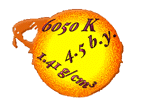The Sun's Vital
Statistics 
The Sun is a rather commonplace celestial object. It is a star of
ordinary dimensions and of ordinary brightness. But to observers on
the Earth, the Sun remains an object of magnificent proportions. This
fiery ball of superheated hydrogen and helium gases contains 99.9
percent of all matter in the Solar System, and a million Earths could
fit inside the Sun, with room to spare.
On this page, we present some of the Sun's vital statistics. We think that
you might be impressed with our magnificent star too.
| Age |
At least 4.5 billion years, in present
state. |
| |
|
| Distance |
|
| |
|
|
Mean distance from Earth
|
1.5 X 10^8 km |
|
Variation in distance through the year
|
+/- 1.5 percent |
| |
|
| Diameter |
1.39 X 10^6 km (or 109 times the
diameter of the Earth and 9.75 times the diameter of Jupiter) |
| Volume |
1.41 X 10^33 cm^3 (or 1.3 million
times the volume of the Earth) |
| Mass |
1.99 X 10^30 kg (or 333,000 times
the weight of the Earth) |
| |
|
| Magnetic Field Strengths (typical): |
|
| |
|
|
Sunspots
|
3000 G |
|
Polar Field
|
1 G |
|
Bright, chromospheric network
|
25 G |
|
Emphemeral (unipolar) active regions
|
20 G |
|
Chromospheric plages
|
200 G |
|
Prominences
|
10 to 100 G |
|
Earth
|
0.7 G at pole |
| |
|
|
Chemical composition of photosphere
(by weight, in percent):
|
|
| |
|
|
Hydrogen
|
73.46 |
|
Helium
|
24.85 |
|
Oxygen
|
0.77 |
|
Carbon
|
0.29 |
|
Iron
|
0.16 |
|
Neon
|
0.12 |
|
Nitrogen
|
0.09 |
|
Silicon
|
0.07 |
|
Magnesium
|
0.05 |
|
Sulfur
|
0.10 |
| |
|
| Density (water=1): |
|
| |
|
|
Mean density of entire Sun
|
1.41 g/cm^3 |
|
Interior (center of the Sun)
|
160 g/cm^3 |
|
Surface (photosphere)
|
10^{-9} g/cm^3 |
|
Chromosphere
|
10^{-12} g/cm^3 |
|
Low corona
|
10^{-16} g/cm^3 |
|
Sea level atmosphere of Earth
|
10^{-3} g/cm^3 |
| |
|
| Solar radiation: |
|
| |
|
|
Entire Sun
|
3.83 X 10^23 kW |
|
Unit area of surface of Sun
|
6.29 X 10^4 kW/m^2 |
|
Received at top of Earth's atmosphere
|
0.136 W/cm^2 |
| |
|
| Surface brightness of the Sun
(photosphere): |
|
| |
|
|
Compared to full Moon
|
398,000 times |
|
Compared to inner corona
|
300,000 times |
|
Compared to outer corona
|
10^10 times |
|
Compared to daytime sky on Pikes Peak
|
100,000 times |
|
Compared to daytime sky at Orange, NJ
|
1000 times |
| |
|
| Temperature: |
|
| |
|
|
Interior (center)
|
15,000,000 K |
|
Surface (effective) of Sun
|
5800 K |
|
Sunspot umbra (typical)
|
4240 K |
|
Penumbra (typical)
|
5680 K |
|
Chromosphere
|
4300 to 50,000 K |
|
Corona
|
800,000 to 3,000,000 K |
| |
|
| Rotation (as seen from the Earth): |
|
| |
|
|
Of solar equator
|
26.8 days |
|
At solar latitude 30 deg
|
28.2 days |
|
At solar latitude 60 deg
|
30.8 days |
|
At solar latitude 75 deg
|
31.8 days |
Source of these numbers are from the book: A New Sun: The Solar
Results From Skylab, by John Eddy, NASA SP-402, 1979, page 37.
The effective solar temperature came from Lang's Astrophysical
Quantities, pg. 162, 1964.
Another Internet site with a smaller "stats" table, but a nice
overview of the important features of the Sun, can be found at
Calvin Hamilton's
Views of the Solar System: Sun.
|

